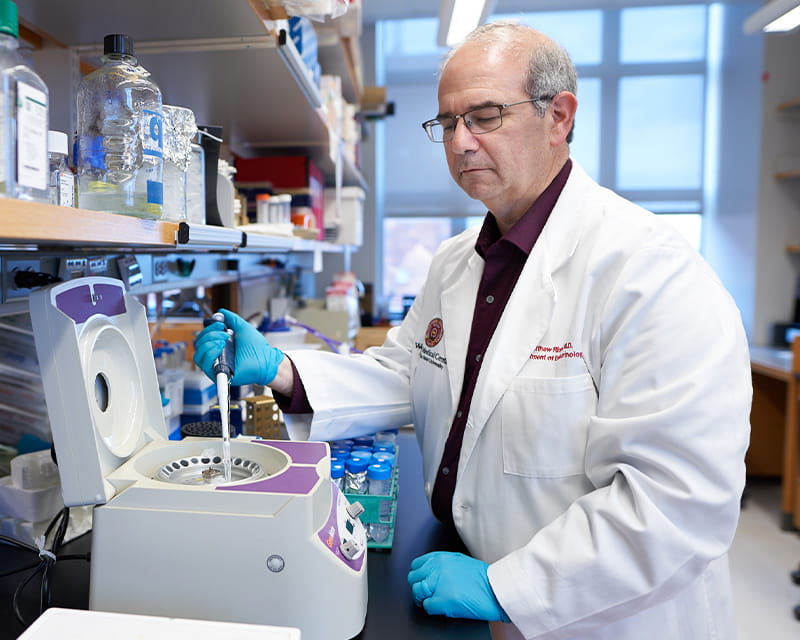
Studying “brake failure” in thyroid cancer metastasis
 “There’s no diagnosis code for a fragility fracture,” says Steven Ing, MD, an endocrinologist with The Ohio State University Wexner Medical Center, “but it’s incredibly important to identify each patient hospitalized for an acute fracture to understand their risk of future fracture and establish steps for formal evaluation and treatment going forward — and these need to be explained to the patient before their discharge.”
“There’s no diagnosis code for a fragility fracture,” says Steven Ing, MD, an endocrinologist with The Ohio State University Wexner Medical Center, “but it’s incredibly important to identify each patient hospitalized for an acute fracture to understand their risk of future fracture and establish steps for formal evaluation and treatment going forward — and these need to be explained to the patient before their discharge.”
This formal approach has been the standard of care at Ohio State since its Secondary Fracture Prevention Program was established in 2014. “We pattern our clinical process to the standard of care used with other emergency scenarios with underlying chronic conditions,” Dr. Ing explains. “If a patient were hospitalized for heart attack, that person would be evaluated for risk factors for coronary disease, and a big part of the mission after discharge would be to reduce those risk factors.”
A second endocrinologist involved with the clinic, Vallikantha Nellaiappan, MBBS, adds, “We want to be proactive in the same way, and our hospitalized patients — most frequently with fractures of the hip, pelvis or spine — deserve the same focused care. Our first priority is to get them into surgery within the first 24 hours. After that, we quickly pivot to make sure there’s a clear fracture prevention pathway in place before they’re discharged, including a confirmed date for a follow-up visit with our program whenever possible.”
“It’s just that important, because data shows these high-risk patients are in imminent danger of more fractures over the next few years.” Dr. Ing says. “While many patients opt to start directly with our program, some prefer to follow up with their primary care physician for long-term bone health. Either way, we’re here to help in any way we can to promote long-term monitoring and risk reduction.” For patients who choose to return to their primary care physician for bone health concerns, Ohio State sends a letter to that physician sharing a list of resources for lowering fracture risk. Laura Phieffer, MD, director of the Division of Orthopaedic Trauma for the Department of Orthopaedics, says, “If the patient transitions to a partnering rehabilitation facility after hospital discharge, an Ohio State orthopedic advanced practice provider attends to the immediate post-fracture needs and also affirms the importance of attending our fracture prevention program, always extending another invitation to anyone who initially declined participation.
“There is then a third touchpoint and follow-up invitation during the patient’s postsurgical visit with the orthopedic team six to eight weeks after hospital discharge. Making sure the patient feels always welcome in our program only reinforces the importance of fracture prevention to them and lets them know we remain an available resource.”
Unlike many other fracture surveillance programs across the country, Ohio State’s is physician-led. The team’s endocrinologists can easily collaborate with other clinic experts, including physical or occupational therapists, nutritionists, pain management specialists and pharmacists. To make it more convenient for the patient, we’ll schedule multiple appointments with different specialists for the same day whenever possible. As an example, our endocrinologists may consider bone anabolic medications following a major fracture, and a pharmacist is available for consultation with both the physician and the patient. “These medications are simply more potent than the oral drugs and offer more fracture protection overall,” Dr. Ing says. “Having a pharmacist available at the clinic itself makes every aspect of this treatment easier.”
The Secondary Fracture Prevention Program also has an active telemedicine service. “Prior to the COVID-19 pandemic, we were planning to conduct research to explore the usefulness of telemedicine for patients with recent hip fracture,” Dr. Ing says. “The rapid adoption of telemedicine during the pandemic proved its effectiveness, and, like others in the medical community, we’ve learned to use telemedicine routinely. For the mobility-challenged, post-fracture patient specifically, we’ve found it to be a great way to offer a valuable appointment alternative.”
With smartphones being commonplace for all ages, even Dr. Ing’s older patients have adopted the technology. If any challenges do arise while using the telemedicine app, he’s found it easy to simply switch to a telephone consultation during the appointment. “Often, the most important part of the visit is counseling and answering questions, and a virtual consultation meets these needs,” he says. “Depending on patient preference, we’re flexible to accommodate both virtual and in-person visits.”
Having seen the positive results of Ohio State’s Secondary Fracture Prevention Program, Dr. Ing has participated in advocacy discussions on fracture liaison service proposals developed and presented to the Centers for Medicare and Medicaid Services for adoption nationwide.
Dr. Ing’s interest in fragility fractures extends to research activities as well. Along with other Ohio State specialists in endocrinology, emergency medicine, orthopedics and biomedical informatics, he co-authored a published paper that compared the overall effectiveness of both a nurse practitioner-led Fracture Liaison Service and the physician-led Fracture Prevention Program at Ohio State, including a review of laboratory assessment, bone density testing and osteoporosis pharmacologic therapy. A second published research article, also co-authored by Dr. Ing and a multidisciplinary team from Ohio State, explores barriers to patient care in fracture prevention that were identified after Ohio State incorporated a patient navigator into its Secondary Fracture Prevention Program.
Dr. Ing’s body of research extends into rare bone and mineral disorders as well, with his latest co-authored study emerging from the 5th International Workshop on Hypoparathyroidism. Published in August 2022, Epidemiology and Financial Burden of Adult Chronic Hypoparathyroidism (hypoPT) summarizes what’s currently known about the prevalence, incidence, mortality, health care burden and complications of chronic hypoPT and describes a research agenda to guide future research in this area.
If you’d like to learn more about the clinical care, education and research activities in Ohio State’s Department of Endocrinology, Diabetes and Metabolism, please visit our webpage.